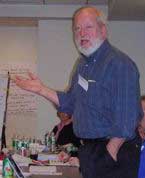[© Copyright. Feel free to link to this blog. Please ask author for permission before copying.]
[Derived from William Bergquist and Agnes Mura, Ten Themes and Variations for Postmodern Leaders and Their Coaches. and from a forthcoming book, William Bergquist and Agnes Mura, Building an Appreciative Organization: Themes and Strategies for Effective Postmodern Leaders, Consultants and Coaches. For information on both books contact Pacific Soundings Press, P. O. Box 70, Harpswell, Maine 04079.]
Theme: The Postmodern Condition
Fundamental Question
What are the paradoxes, whip lashing contradictions and dizzying changes of which our world is made, and how might an appreciative perspective assist in responding to the challenges of this postmodern condition?
Many 21st Century societies today are faced with three challenging conditions. First, they are guided by a fragmented and often paradoxical image of their present condition and their future condition. Their present condition includes both a strong trend toward globalization and an equally strong trend toward localization. We live in a world that challenges us to be aware of and interact with other people and cultures throughout the world – Thomas Friedman’s flat world—while also challenging us to retain our local customs and loyalties (a new form of tribalism) leading to what Robert Bellah and his colleagues describe as isolating “life style enclaves.”
Second, we are faced with what Frederick Jameson identifies as the condition of “troubling ambiguity.” Boundaries of all sorts are being shattered or are shifting in unpredictable ways – boundaries between work and home, between countries, between private and public lives, between being inside an organization and being affiliated loosely with an organization.
Third, leadership is being defined in new ways—the old distinction between the task-oriented leader and the people-oriented leader is no longer sufficient, given the other postmodern challenges facing contemporary organizations and societies. Leaders are successful to the extent that they can embrace a broad repertoire of strategies and serve as learners (not just sources of wisdom), risk-takers and entrepreneurs (not just fight leaders) and servants of a compelling image of the future (not just visionaries).
Given the postmodern interplay between globalization and localization, we can expect many leaders to simultaneously play on the global stage and the local stage. We can also expect them to be deeply embedded in their own organization (as a new neighborhood) while seeking to retain a viable family and community life. The boundaries between work and home are inevitably blurred, leaving little time, in many instances, for leaders to reflect or plan ahead. These postmodern conditions confront the leader with challenges that require both courage and insight. If leadership is situational, coaching and consulting programs are called upon to provide leadership development of the most customized and “just-in-time” kind.
In this essay and in the next three essays on this blog, we examine these postmodern conditions and begin to explore ways in which an appreciative perspective can help to not only illuminate some of these conditions but also provide us with preliminary strategies for dealing with the complexity, unpredictability and turbulence of postmodern life.
The Postmodern Revolution
I cannot remember exactly when I first encountered the term postmodernism. I probably reacted to it in much the same way as I did to the various other “isms” that have come and gone over the past couple of decades, hoping that it would disappear under the weight of its own incoherence or simply lose its allure as a fashionable set of ‘new ideas.’ But it seemed as if the clamour of postmodernist arguments increased rather than diminished with time. Once connected with poststructuralism, postindustrialism, and a whole arsenal of other ‘new ideas,’ postmodernism appeared more and more as a powerful configuration of new sentiments and thoughts.
– David Harvey, The Condition of Postmodernity
As leaders we are entering a changing world of relationships and ideas. It is often called “the postmodern revolution.” The postmodern world is in the midst of being born. It does not yet have clear definition, other than its origins in and difference from the modern era. Hence the name postmodern. It is still defined with reference to its mother (modernism) rather than having broken off as a free and independent movement or set of ideas and images with its own distinctive name. Even though postmodernism is young and therefore still filled with superficial, facile and often internally contradictory analyses, it cannot be dismissed, for these analyses offer insightful and even essential perspectives and critiques regarding an emerging era.
In the postmodern camp there is neither the interest in the systematic building of theory, nor the interest in warfare between competing paradigms. Rather everything is pre-paradigmatic, i.e. there is an attempt to live and function without the scaffolding of paradigms of thought. One of the reasons for such a divestiture is seemingly the sheer impossibility of “knowing.” Tom Peters acknowledges that in the early 1980s he knew something about how organizations achieved excellence. By the late 1980s, he discovered that he was mistaken. Many of the excellent organizations of the early 1980s became troubled institutions by the late 1980s.
Other theorists and social observers have been similarly humbled by the extraordinary events of the 1980s and 1990s. They just haven’t been as forthcoming (or opportunistic) as Tom Peters.
“Postmodernism at its deepest level,” notes Andreas Huyssen, “represents not just another crisis within the perpetual cycle of boom and bust, exhaustion and renewal, which has characterized the trajectory of modernist culture.” Rather, the postmodern condition “represents a new type of crisis of that modernist culture itself.” Many futurists (especially those who focus on the environment) similarly speak of a crisis-of-crises. This crisis-of-crises and the ambiguity, the paradoxes and the irony that accompany this era of grand questioning are founded in the interplay between globalization and localization and, even more fundamentally, in the interplay between order and chaos as we are beginning to understand them. We turn in our next essays to a more in-depth analysis of these crisis-of-crises.



 Posted by William Bergquist
Posted by William Bergquist 